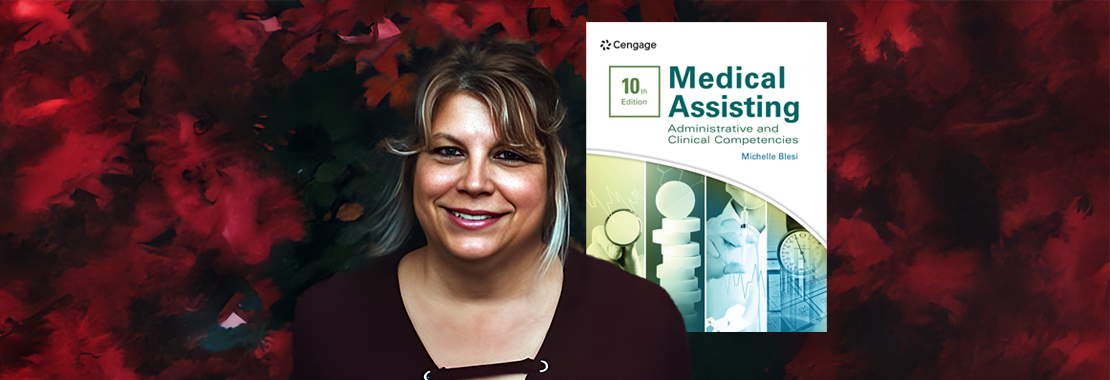Tell us a little bit about yourself and your background (current title, professional milestones, professional history, education, research works, hobbies, etc.)
I am a Certified Medical Assistant with 39 years of industry and education experience combined. I worked in a family practice clinic for 10 years, emphasizing patient care while completing clinical and laboratory skills. Changing my focus to leadership, I then worked as a lead in the nursing/lab departments and as a Clinical Manager, prior to switching careers. In 2001, I was hired as a full-time educator, Practicum Coordinator and Program Director at Century Community and Technical College in White Bear Lake, MN.
I have a diploma in medical assisting and am certified through the American Association of Medical Assistants (AAMA.) I also have a bachelor’s degree in psychology and a master’s degree in community psychology. In spring 2005, I completed the TES (Teacher Education Series) courses at the University of Minnesota, earning my teaching license in vocational education.
I enjoy bringing my career experience into the classroom and making a difference in students’ lives. In addition to being Program Director, I teach both clinical and laboratory courses, a medical assistant refresher course through CECT and Administrative Procedures for Medical Assistants, both in-person and online. Additionally, in my role as the Practicum Coordinator, I oversee all of the clinical externship/practicums for the program. In addition to sitting on numerous committees and work groups over my career span, I have also authored the past four editions of “Medical Assisting: Administrative and Clinical Competencies.”
In my free time I enjoy hiking, camping, reading, music, gardening, entertaining and spending time with family and friends.
Tell us about the Medical Assistant program at Century College. What are the most rewarding aspects of teaching the program?
The Medical Assistant program at Century College has grown significantly since I started in 2001. Originally, I was teaching classes with approximately five students and a total of 8-10 students overall in the program. Today’s classrooms have 20 students in each, for an overall total of 120 students enrolled in the program. We have two courses (Administrative Procedures and Pharmacology) which students can take prior to starting the program. We hold practicums/externships every spring and summer. Fall sessions are available for any students who may have stopped out and returned.
There are several rewarding things about teaching in the MA program. These include seeing the students understand the concepts, excel at the skills, complete the program course, pass the certification exam and get their first job as a medical assistant. Their success is my success. As of date, I’ve had over 1000 students graduate from the program. I couldn’t be prouder of that fact.
What are the biggest challenges?
As for challenges, I’d say the biggest is keeping the enrollment up. We don’t have an abundance of students enrolling. I’d love to see that change. I love seeing high school graduates, people looking for a career change or just people in general who want to contribute and make a change in people’s lives, join the field. Another challenge is teaching up to 20 different levels of students in one classroom and being able to meet the needs of all learners. Depending on their preparedness level prior to joining the program, it can be challenging at times.
How has the Medical Assistant program changed over the past few years? How have you adapted your teaching to reflect those changes?
Having to adjust to the learning levels of individual students has been quite a change over the years. I always take it to them and say, “Tell me how you learn best,” and “How can we help you to be successful in your learning path?” We have created language guides using many of the terms found in the coursework to help students comprehend the content better. We have developed an ambassador program within our program where peer-chosen students serve as classroom leaders to assist the faculty with study groups and program outreach.
I am always researching the best practices and making changes so students can learn better. We survey the students and make changes based off their feedback. We also meet with every single student each semester to work on affective skills. Students set goals to keep their education and learning on track for success.
How has your work at Century College influenced your work on Medical Assisting: Administrative and Clinical Competencies? What is distinctive about the text? What are your suggestions for instructors getting started with it?
My work has always revolved around wanting to have the best for the students. My students are great at telling me what they need and how materials we have help them learn the content necessary to be a successful MA. I wanted a product that made learning easier for both the student and the educator, while including all the required standards and assessments. When I first started in education back in 2001, I couldn’t find a product that had everything I felt students needed or I needed as an educator. I was having to supplement quite a bit and create a lot of my own materials to meet the needs. I was fortunate when I voiced these issues to a Cengage product developer. They were willing to listen and invited me to join them in creating content. Here I am close to 20 years later, continuing to do so.
“Medical Assisting: Administrative and Clinical Competencies,” 10th Edition is a proven, competency-based learning system with a 40-year history of success. The text associates each learning module with the needs of students and the demands of the workforce. It’s a personalized experience rather than a one-size-fits-all model. The text is written in an interesting, easy-to-understand format and covers the knowledge, skills, behaviors and values necessary to prepare students to become thriving, multiskilled medical assistants.
This textbook can be used in a variety of settings:
- A structured classroom
- Individualized instruction of learning — much of the content and format is appropriate for self-study
- On-the-job training in a provider’s office, where the learning package serves as a supplement to employee instruction and as a resource manual
- Certification exam preparation
I would advise instructors to ask for training on this product and all the ancillaries that are available with it. Don’t try and do it all alone. There are many educators using the product. There’s also on-demand online training and virtual training that can be set up to help them get started. There are so many tools that can make their lives and educational experience easier.
How does MindTap connect to your text? How do you use it in your courses? What are your suggestions for professors getting started with MindTap?
This textbook also includes an updated MindTap. We’ve reviewed all activities and assessment questions to ensure alignment with the 10th edition objectives.
New features and updates include:
- Medical Assisting Virtual Skills activities: Included in select chapters, these activities walk students through performing various skills in the medical office, from effectively addressing patient questions on the phone to assisting with a variety of patient exams and procedures.
- Medical Office Simulation Software (4.0): This updated software features a Demographics screen, six new activities and ICD-10-CM and CPT codes.
- Medical Assisting Exam Review Online (4.0): This software is fully updated.
- Image labeling activities: Each chapter in Unit 2: Anatomy and Physiology of the Human Body includes new image labeling activities.
I use some of the exercises in MindTap as part of the students’ graded course materials. Some of the content is for student practice only. They can use it at their leisure. The competency checklists are all downloadable and customizable. You can add or remove any content to fit you and your students’ needs. In my student surveys, over 95% comment on how MindTap is one of the best resources they’ve used throughout the program. MOSS is a great way to get students acclimated to electronic record information entry. And the MAERO certification review questions assist my students with passing their certification exams successfully.
How do you see this text deepening students’ engagement with medical assisting and fostering more active engagement with core concepts? What is the most significant takeaway students will carry with them after using this textbook?
The text is such a great resource for the students in so many ways. It’s not just a textbook needed for a course. It has a wealth of information that enables them to make connections between the content and the hands-on skills needed to perform the tasks of a medical assistant. I run into students in the field all the time. Over 1000 past students are out in the workforce. They’re still using the text as a resource well after they have completed the program and are employed.
Having a variety of exercises in MindTap makes learning so much more meaningful and fun for students. I have yet to meet a student who did not find value in the text and the ancillary resources that go along with it. In fact, I hear from employers that use it when past students bring it in to refresh their own employees on updated skills that they may not have been aware of. I like to think of it as a gift that keeps on giving.
 Michelle Blesi is a Certified Medical Assistant, Program Director and faculty member in the Medical Assistant Department at Century College. She has a diploma in medical assisting and is certified through the American Association of Medical Assistants AAMA. She also has a bachelor’s degree in psychology and a master’s degree in community psychology. She completed the TES (Teacher Education Series) courses in spring 2005 at the University of Minnesota. She is the recipient of numerous awards, including the 2021-2022 League Excellence Award and the 2016 Minnesota State: Academic and Student Affairs Division Excellence in Curriculum Programming Award.
Michelle Blesi is a Certified Medical Assistant, Program Director and faculty member in the Medical Assistant Department at Century College. She has a diploma in medical assisting and is certified through the American Association of Medical Assistants AAMA. She also has a bachelor’s degree in psychology and a master’s degree in community psychology. She completed the TES (Teacher Education Series) courses in spring 2005 at the University of Minnesota. She is the recipient of numerous awards, including the 2021-2022 League Excellence Award and the 2016 Minnesota State: Academic and Student Affairs Division Excellence in Curriculum Programming Award.

